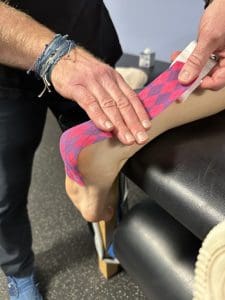 When watching any sporting event now you will notice athletes with brightly colored taping over various parts of their body. That tape is a specialized type of tape called Kinesiotape (or KT for short). KT treatment has gained a lot of popularity as a non-invasive form of therapy used to support injured muscles, facilitate the body’s natural healing process, and potentially improve performance. At it’s most basic KT taping utilizes an elastic tape that creates it’s desired treatment effect based on the amount of stretch in the tape when applied to the skin.
When watching any sporting event now you will notice athletes with brightly colored taping over various parts of their body. That tape is a specialized type of tape called Kinesiotape (or KT for short). KT treatment has gained a lot of popularity as a non-invasive form of therapy used to support injured muscles, facilitate the body’s natural healing process, and potentially improve performance. At it’s most basic KT taping utilizes an elastic tape that creates it’s desired treatment effect based on the amount of stretch in the tape when applied to the skin.
How does Kinesiotaping work?
To understand the basic principles of KT taping you have to understand how the tape is applied to the skin. Each strip is placed onto the skin with no tension in the elastic tape. It is then stretched over the treatment area at a given percentage of stretch depending on the desired treatment outcome and then anchored again without any tension. The elasticity of the KT pulls the skin up and away from the superficial blood supply along the stretched area of the tape which will improve blood circulation to the treated skin and underlying fascia. This uplifting effect will improve blood circulation, remove cellular waste, reduces pressure on the pain receptors, promote a better healing environment, can create biofeedback in an area, and generally help improve an injury. All in a more natural and non-invasive way.
“The benefit of KT taping in Physical Therapy is just how versatile KT is” reports Dr. Brian Ireland, PT, DPT. “Depending on the specific needs and goals of the individual, the application technique changes”.
 Some examples of KT in our Physical Therapy practice are, in areas of soft tissue immobility due to injury, by having both ends of the tape anchored on healthy mobile skin every time the healthy skin moves it will pull the immobile skin creating a non-invasive “massaging” effect to the skin in an effort to improve tissue mobility. When athletes have muscle sprains the KT can be effective at inhibiting muscle stretching and provide biofeeback, allowing an athlete to return back to competition more quickly. In instances of joint instability KT can be used to help facilitate surrounding muscles to “fire up” and stabilize the respective joints more consistently. Kinesiotaping is terrific at helping to reduce bruising and soft tissue swelling that commonly occurs with injuries, much quicker than traditional techniques.
Some examples of KT in our Physical Therapy practice are, in areas of soft tissue immobility due to injury, by having both ends of the tape anchored on healthy mobile skin every time the healthy skin moves it will pull the immobile skin creating a non-invasive “massaging” effect to the skin in an effort to improve tissue mobility. When athletes have muscle sprains the KT can be effective at inhibiting muscle stretching and provide biofeeback, allowing an athlete to return back to competition more quickly. In instances of joint instability KT can be used to help facilitate surrounding muscles to “fire up” and stabilize the respective joints more consistently. Kinesiotaping is terrific at helping to reduce bruising and soft tissue swelling that commonly occurs with injuries, much quicker than traditional techniques.
This non-invasive and versatile approach to help support injured muscles and speed up the rehabilitation process has gained a lot of traction as an adjunct to any physical therapy program as it helps to support all types of injuries. Kinesiotaping treatment helps athletes, individuals that are recovering from an injury, or individuals that want pain relief. If this therapy seems as if it would be something that could help benefit you, give us a call to make an appointment at BeneFit Physical Therapy where we can evaluate just how kinesiotape can best help you!



